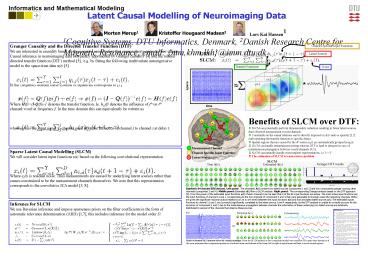Latent Causal Modelling of Neuroimaging Data - PowerPoint PPT Presentation
Title:
Latent Causal Modelling of Neuroimaging Data
Description:
Granger Causality and the Directed Transfer Function (DTF) We are interested in causality based on the common sense notion that causes always precede their effects. – PowerPoint PPT presentation
Number of Views:44
Avg rating:3.0/5.0
Title: Latent Causal Modelling of Neuroimaging Data
1
Informatics and Mathematical Modeling
Latent Causal Modelling of Neuroimaging Data
Lars Kai Hansen1
Morten Mørup1
Kristoffer Hougaard Madsen2
1Cognitive Systems, DTU Informatics, Denmark,
2Danish Research Centre for Magnetic Resonance,
email mm,khm,lkh_at_imm.dtu.dk
Granger Causality and the Directed Transfer
Function (DTF) We are interested in causality
based on the common sense notion that causes
always precede their effects. Causal inference in
neuroimaging data is typically approached by
Granger causality 4 and the related directed
transfer function (DTF) method 5., e.g. by
fitting the following multivariate autoregressive
model to the space-time data x(t) 5 In the
frequency domain these systems of equations
correspond to 5 Where H(f)(I-Q(f))-1
denotes the transfer function. Ie. hi,j(f)
denotes the influence of jth on ith channel/voxel
at frequency f. In the time domain this can
equivalently be written as where ej(t) is the
input signal to channel j and hi,j(t) the
influence of channel j to channel i at delay t.
Channel Specific Input Functions
Latent Sources
Transfer Functions
Noise
e4
- Benefits of SLCM over DTF
- SLCM can potentially perform dimensionality
reduction resulting in fewer latent sources than
observed measurement voxels/channels. - Constraints on the causal relations can be
directly imposed on A(t) such as sparsity 2,7
and restricting the transfer function to specific
delays. - Spatial regions that are caused by the dth
source sd(t) are automatically grouped in ad(t). - SLCM can handle instantaneous mixing whereas DTF
is hard to interpret in case of instantaneous
propagation between voxels/channels 4,5. - SLCM can naturally handle overcomplete
representations, i.e. IgtgtT. - The estimation of SLCM is a non-convex problem
x4
e5
x5
e2
e3
x2
s2
x3
x6
e1
e6
s1
x1
Measurement Channel
Sparse Latent Causal Modelling (SLCM) We will
consider latent input functions s(t) based on the
following convolutional representation Where
ei(t) is residual noise. Thus measurements are
caused by underlying latent sources rather than
causes constrained to be the measurement channels
themselves. We note that this representation
corresponds to the convolutive ICA model 3, 8.
Channel Specific Input Function
Latent Source
SLCM
Synthetic 64 channel EEG dataset. Left panel
The simulated A(t) contains two latent sources
(component 1 and 2) and two components granger
causing other channels (component 3 and 4).
Middle panel Estimated A(t) from a SLCM
analysis. Right panel The corresponding Granger
analysis based on the DTF approach 5. From the
power of the estimated input functions e(t) of
each channel it can be seen that 9 of the 64
input functions are active. The most active input
functions are the input functions of channel 11
and 1 corresponding to the two channels of
component 3 and 4 that were generated to Granger
cause the remaining channels. Below are given the
significant maximal autocorrelations (on an a1
level) between the input functions e(t) and true
simulated latent sources s(t). The estimated
inputs functions to channel 11 and 1 are
(correctly) significantly correlated to the
latent source 3 and 4 respectively. As the DTF
analysis is unable to correctly account for the
dynamics of component 1 and 2 due to the
instantaneous propagation between channels the
information of these underlying two latent
sources are arbitrarily distributed to several of
the channels that observe these sources.
Inference for SLCM We use Bayesian inference and
impose sparseness priors on the filter
coefficients in the form of automatic relevance
determination (ARD) 1,7, this includes
inference for the model order D.
Real 64 channel EEG dataset based on visual
paradigm. From the SLCM analysis a four component
model was extracted. The space-time dynamics of
the most prominent first component pertain to
visual activation and indicate a flow from left
to right occipital areas and later to more
central regions.

